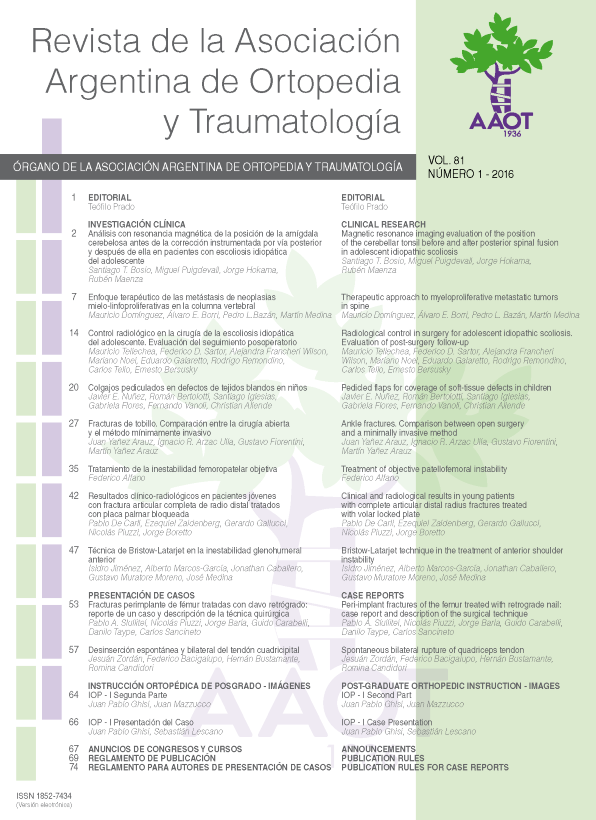Clinical and Radiological Results in Young Patients with Complete Articular Distal Radius Fractures Treated with Volar Locked Plate.
Main Article Content
Abstract
Downloads
Metrics
Article Details

This work is licensed under a Creative Commons Attribution-NonCommercial-ShareAlike 4.0 International License.
Manuscript acceptance by the Journal implies the simultaneous non-submission to any other journal or publishing house. The RAAOT is under the Licencia Creative Commnos Atribución-NoComercial-Compartir Obras Derivadas Igual 4.0 Internacional (CC-BY-NC.SA 4.0) (http://creativecommons.org/licences/by-nc-sa/4.0/deed.es). Articles can be shared, copied, distributed, modified, altered, transformed into a derivative work, executed and publicly communicated, provided a) the authors and the original publication (Journal, Publisher and URL) are mentioned, b) they are not used for commercial purposes, c) the same terms of the license are maintained.
In the event that the manuscript is approved for its next publication, the authors retain the copyright and will assign to the journal the rights of publication, edition, reproduction, distribution, exhibition and communication at a national and international level in the different databases. data, repositories and portals.
It is hereby stated that the mentioned manuscript has not been published and that it is not being printed in any other national or foreign journal.
The authors hereby accept the necessary modifications, suggested by the reviewers, in order to adapt the manuscript to the style and publication rules of this Journal.
References
2. Boretto JG, Gallucci GL, Alfie VA, Donndorff A, De Carli P. Dorsally displaced intra-articular distal radius fractures treated by locked palmar plate. Technique and results. Chir Main. 2009;28(1):18-25
3. Catalano LW 3rd, Cole RJ, Gelberman RH, et al. Displaced intra-articular fractures of the distal aspect of the radius: long-term results in young adults after open reduction and internal fixation. J Bone Joint Surg [Am] 1997;79- A:1290-302.
4. Chung KC, Squitieri L, Kim HM. Comparative outcomes study using the volar locking plating system for distal radius fractures in both young adults and adults older than 60 years. J Hand Surg Am. 2008 Jul-Aug;33(6):809-19.
5. Figl M, Weninger P, Jurkowitsch J, Hofbauer M, Schauer J, Leixnering M., Unstable distal radius fractures in the elderly patient--volar fixed-angle plate
osteosynthesis prevents secondary loss of reduction”. J Trauma. 2010 Apr; 68(4):992-8.
6. Fok MW, Klausmeyer MA, Fernandez DL, Orbay JL, Bergada AL. Volar plate fixation of intra-articular distal radius fractures: a retrospective study. J Wrist Surg. 2013 Aug;2(3):247-54.
7. Gliatis JD, Plessas SJ, Davis TR: Outcome of distal radial fractures in young adults. J Hand Surg [Br] 2000, 25(6):535–543
8. Karantana A, Downing ND, Forward DP, et al. Surgical treatment of distal radial fractures with a volar locking plate versus conventional percutaneous methods: a randomized controlled trial. J Bone Joint Surg Am. 2013;95(19):1737-44.
9. Knirk JL, Jupiter JB. Intra-articular fractures of the distal end of the radius in young adults. J Bone Joint Surg [Am] 1986;68-A:647-59.
10. Kopylov P, Johnell O, Redlund-Johnell I, Bengner U. Fractures of the distal end of the radius in young adults: a 30-year follow-up. J Hand Surg [Br] 1993;18:45-9.
11. Kreder HJ, Hanel DP, McKee M, Jupiter J, McGillivary G, Swiontkowski MF. X-ray film measurements for healed distal radius fractures. J Hand Surg Am. 1996;21:31-9.
12. Lindau TR, Arner M, Hagberg L: Intraarticular lesions in distal fractures of the radius in young adults. A descriptive arthroscopic study in 50 patients. J Hand Surg [Br] 1997, 22B:638–643.
13. Soong M, Van Leerdam R, Guitton TG, Got C, Katarincic J, Ring D. Fracture of the distal radius: risk factors for complications after locked volar plate fixation. J Hand Surg Am. 2011;36(1):3-9.
14. Trumble TE, Schmitt SR, Vedder NB.” Factors affecting functional outcome of displaced intra-articular distal radius fractures”. J Hand Surg 1994;19A:325–340.
15. Wright TW, Horodyski M, Smith DW. Functional outcome of unstable distal radius fractures: ORIF with a volar fixed-angle tine plate versus external fixation. J Hand Surg Am. 2005;30(2):289-99.

